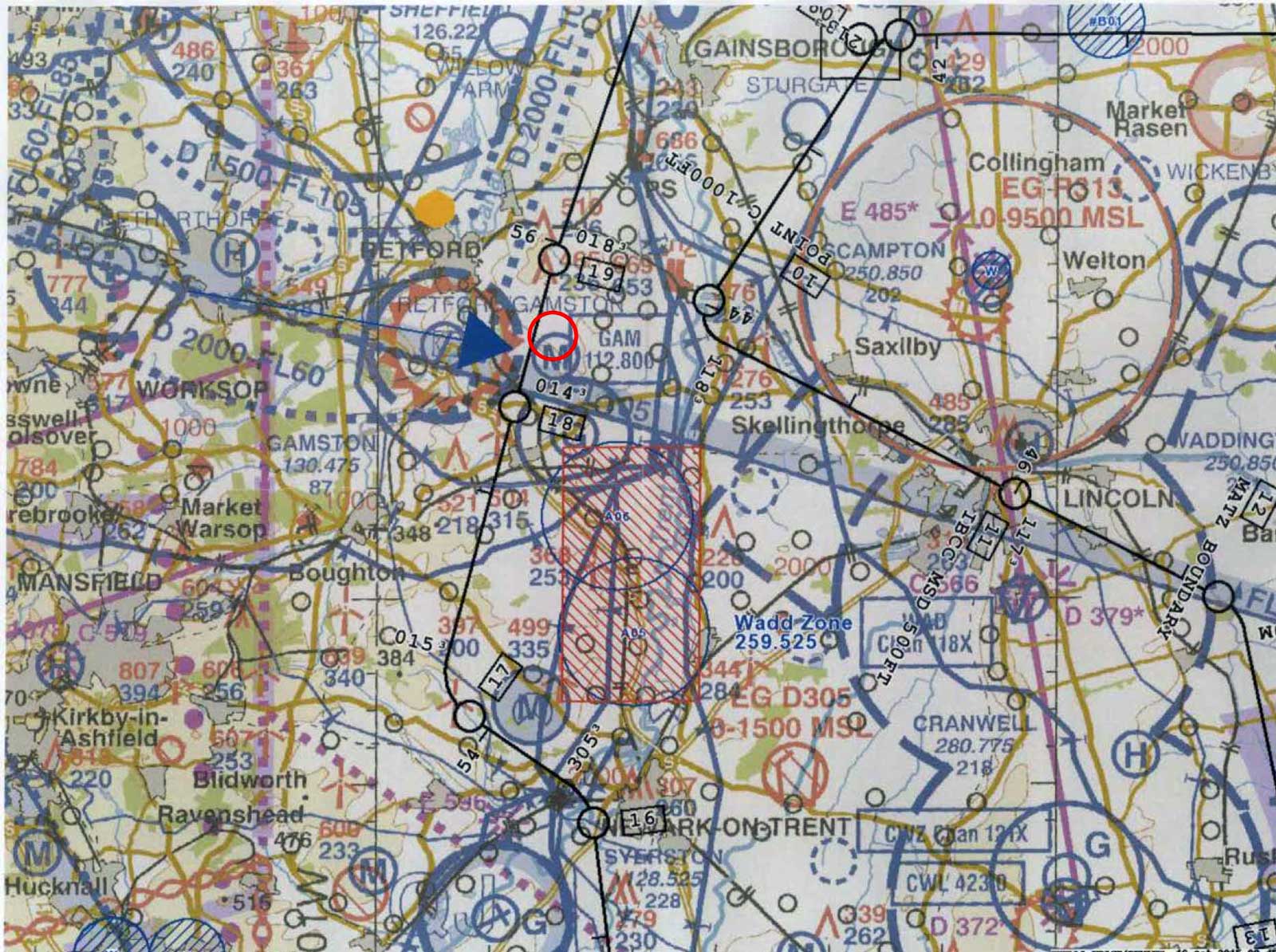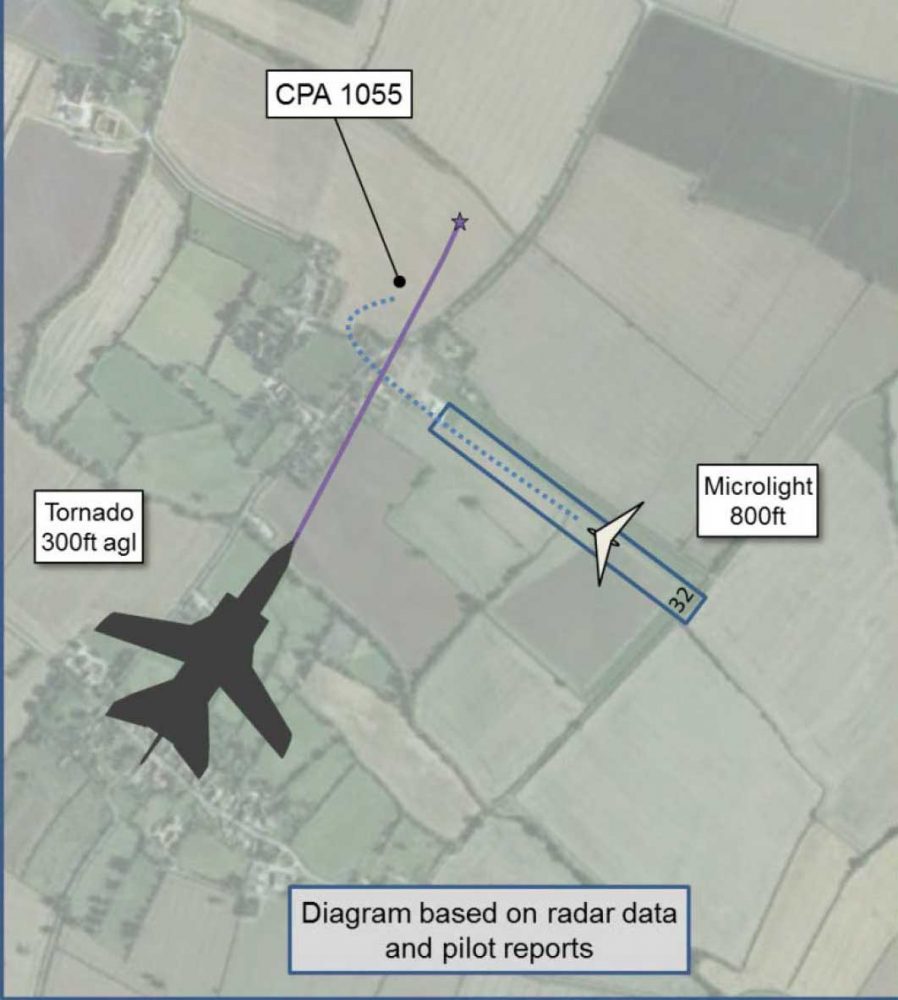A Tornado fast jet flew 300 feet under a Blade flex-wing microlight as the microlight was preparing to land at Headon Airfield, near Retford, Notts, according to the latest batch of UK Airprox reports.
The microlight pilot was turning right to position for downwind for runway 32 at Headon when he saw the RAF Tornado pass below him and slightly to his right. There was no time to take avoiding action, said the pilot. He assessed the risk of collision as ‘High’.
During an investigation by the RAF unit involved, it was noted that the co-ordinates given in the military version of the Aeronautical Information Publication (AIP) placed Headon Airfield 0.5nm NNW of the airfield’s actual location. See the CAA chart below. “This contributed to the Tornado;s flying closer to the airfield than the pilot planned,” said the RAF report.

Military coordinates wrongly located Headon Airfield. Red circle shows where RAF thought it was. This contributed to the airprox. Top image shows how the fast jet came close to the landing microlight. [Images: UK Airprox Board].
The incident has been widely discussed with the UK RAF fast jet community and a review of the Low Flying System is underway.
The UK Airprox Board rated the incident as ‘Class A’, the highest risk. It said, “Without wishing to go over this old ground again, the Board felt that although he had been entitled to fly where he had in the Low Flying System (LFS), the Tornado pilot would probably have been better placed to have remained at height until further north due to the myriad of small airfields and avoidances in that particular area.
“Essentially, the Tornado pilot was threading the gap very finely between these airfields and, although his planned routing would have taken him clear of Headon airfield had it been marked on the charts correctly, he had left very little margin for error.”
UK Airprox Board latest reports














5 comments
What! I love how aviation speak (especially military aviationspeak) raises the cockup to the level of a skill, viz: “the Tornado pilot was threading the gap very finely between these airfields” which makes him out to be an aeronautical surgeon instead of a fool. Because only a fool would be at 200kts.
The UK is divided into 20 separate low flying areas (LFAs). 3 of these areas are also known as Tactical Training Areas (TTAs) and only these three have timetables published according to: https://www.gov.uk/guidance/military-low-flying . So the RAF guys who are practicing saving the nation in the other 17 areas can mow us down?
I have a feeling the PPL average guy is more of a problem than a trained RAF pilot 🙂 200knts is not fast, cars are faster than that. Air law, looking aroiund and maintaining the correct height is important; here was an RAF mappinmg error, noone else did anything wrong.
People go on about this too much we’ll all need more expensive kit!
Had I been the microlight pilot, my main concern would have been wake turbulence. In a low-wing-loading aircraft it would be quite feasible to be flipped inverted at low level, and you’re far more likely to hit the wake than to collide with the aircraft itself. So whilst I have no desire to take the RAF pilot to task, it is a big deal.
The two points are clear; there was a mapping error and the RAF have right of way (might is right), however the MOD seem to have taken this seriously, although I would like to see some evidence that the MOD mapping has been audited throughout the UK and revised and amended where necessary, I don’t think we can automatically assume this has been done, how many other 0.5 mile mapping errors might there be?
We all have to co-exist on a small Island and inevitably there will be close encounters of the fast jet kind. Quite why the RAF feel the need to low-fly in that particular area is unknown to me unless it is an ongoing check to see if we can peacefully coexist. Clearly we can – with some exceptions. Unfortunately the exceptions can be fatal. The easiest way to avoid any possibility of a mid-air (military or otherwise) is to stay on the ground. It’s worked for me…